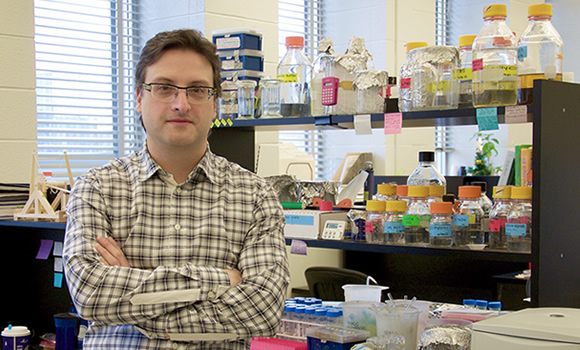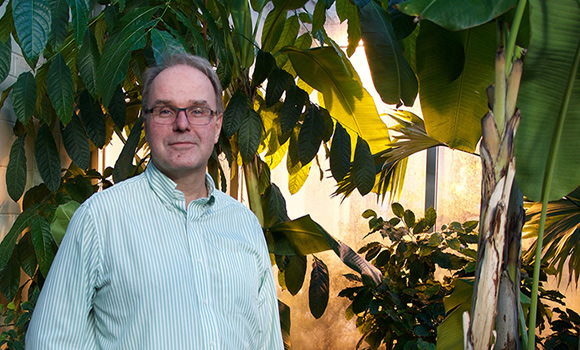Technological advances — rapid sequencing of genomes, genetic engineering, remote sensing, advanced computational platforms — now allow researchers to answer questions previously beyond our scope, develop entirely new areas of research, and provide important insight into diverse and significant challenges facing the world.
Here’s what the heads of our Cell & Systems Biology and Ecology & Evolutionary Biology departments see coming soon.

Vince Tropepe
Chair, Department of Cell & Systems Biology
For Cell & Systems Biology, a key focus is on genome editing, a technology that holds promise to revolutionize the treatment of disease.
Genome editing: a true scientific breakthrough
Genome editing enables a precise functional interrogation of the genome using relatively simple experimental methods. Genome editing technologies enable researchers to modify the DNA sequence of virtually any cell type, in almost any organism. This opens the door to significantly improving our understanding of how the genome works in much greater detail, and has the potential to usher in a new class of therapeutics for a broad range of diseases.
The most common approach uses a tool called CRISPR/Cas9 technology to edit — that is, change the sequence — of DNA at precisely defined regions of the genome. This enables researchers to create mutations in DNA sequences that are thought to be critical for normal cell function in experimental animals or in human cultured cells. For example, the precision of the CRISPR/Cas9 technique allows one to simulate human gene mutations in an animal model to study the disease process.
The molecular tools for genome editing are becoming extremely versatile and their more recent derivatives will undoubtedly revolutionize our ability to precisely analyze — and control — the genome. Researchers are now adapting the CRISPR/Cas9 system to introduce new DNA sequences at predefined locations to study how the topological organization of the genome influences its function, or to ‘tag’ genes with fluorescent reporters to be able to track the location and quantity of the protein products inside cells with incredible accuracy.
Perhaps most strikingly, a modified version of this technique is being used to precisely regulate the activation of gene transcription. In other words, researchers are harnessing the power of CRISPR/Cas9 to turn genes on or off in a controlled manner, but without changing the DNA sequence.
“Shock and kill” strategy might lead to a permanent cure for AIDS
Implications of this technology for precision medicine are very exciting. One promising application focuses on the permanent elimination of HIV in latently infected cells that escape even the best antiretroviral therapies. Using CRISPR/Cas9, the dormant HIV genome can be precisely targeted and activated such that latently infected cells are now susceptible to antiretroviral drugs. This “shock and kill” strategy might lead to a permanent cure for AIDS.
The technology is not without controversy, however, especially when it involves manipulating human cells. In the case of personalized regenerative medicine, for example, it can be used to predictably change the identity of master stem cells into more specialized cells that can be used to repair damaged or diseased tissues.
Many would argue that the potential medical benefit of genome editing in this context is unassailable. However, it becomes more contentious when one considers that the same technology can be used to edit the genome in human sperm or egg cells, or even single-cell embryos. A major concern is that these forms of genome editing increase the risk of abuse for eugenics or embryo enhancement. Thus, genome editing for reproductive purposes is prohibited in many countries either by legislation, like in Canada, or by strict guidelines, and should remain prohibited until such time that socially acceptable uses of it — if any — are identified.
Genome sequencing has revolutionized our understanding of many species
In the last decade, genome sequencing has revolutionized our ability to understand many different kinds of plant, animal, and microbial species at their most fundamental level. However, the ability to precisely manipulate the information available in DNA is transforming our descriptive understanding of the genome to one that is much more mechanistic. Genome editing, and its derivative technologies, are catapulting experimental biology to new heights and bring unprecedented insight into the nature of diverse biological systems.

Don Jackson
Chair, Department of Ecology & Evolutionary Biology
Global environmental changes are dramatically changing the way living organisms interact with one another and their environments.
Solving problems from drug-resistant diseases to feeding the world
The ecological and evolutionary dynamics of organisms are behind some stark and pressing social problems. Antibiotic resistance presents huge challenges in treating patients suffering life-threatening drug-resistant bacterial infections. Herbicide-resistant weeds and disease-ridden livestock increasingly challenge farmers’ abilities to produce food to feed the world.
New approaches, such as evolutionary genomics, allow us to better identify problems and to develop solutions.
Our researchers are making advances in fundamental questions about how sexual reproduction arose, how species form and how sex-determining chromosomes evolve. Interdisciplinary research is increasingly important to identify both problems and solutions. Evolutionary medicine, for example, integrates the ecological and evolutionary aspects of disease to develop enhanced medical treatment regimens.
Climate change changes everything
Large environmental perturbations like climate change pose significant threats to species around the world. The rapid pace of change makes it difficult or impossible for many species to adapt or colonize more favourable environments. Climate change stresses ecosystem function by altering the timing and the synchrony of ecological events. For example, the flowering time of plants may shift, yet their pollinators may not shift in a similar way, resulting in the failure or disruption of important fruits and seeds that are valuable as food to humans, as well as altering food webs that lead to the loss of many species.
Increased temperatures may exceed a plant’s thermal tolerances. Important agricultural crops, such as rice, grow in many areas of the world at temperatures that are very close to the levels at which plants may become sterile.
Relatively small increases or unpredictable fluctuations in temperature might cause large-scale crop loss and associated famine.
Solutions to food supply — like aquaculture — can bring new challenges
Invasive species present significant challenges to maintaining food supplies as well as the biodiversity of our world. They are increasingly successful due to environments being altered by factors such as climate change.
While aquaculture permits enhanced food production, it also introduces “hot spots” of pathogens that may negatively affect wild fish populations.
These various factors all interact to increasingly threaten Earth’s biodiversity. Research in conservation biology seeks to understand the causes and solutions to minimize the potential for species loss.
As humanity grows in size and imposes greater demands on the planet, it becomes increasingly important to understand how alterations to one part of the natural world — such as farming on land or in the oceans — impacts other parts. How we can support our demands while minimizing the impacts on the world’s biodiversity is a challenge that will continue to increase in importance.

